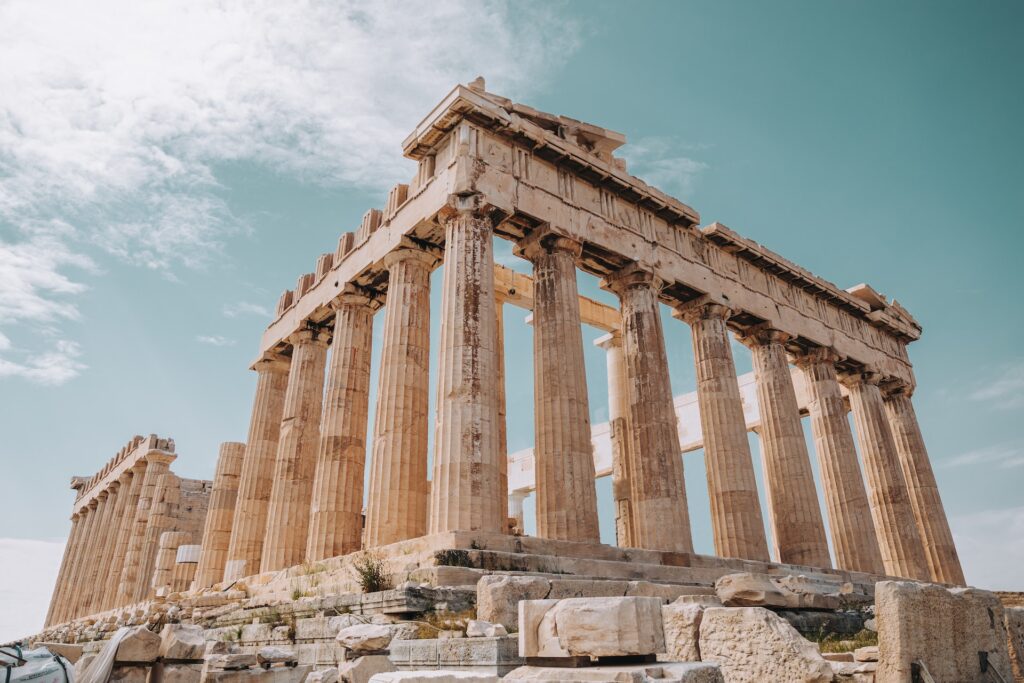This page may contain affiliate links, which means I may receive a commission from purchases made through links.
Early in his ministry, Jesus turned water into wine. This was his first miracle, or “sign,” as John likes to call it. Soon after this event, it came time for Jews to celebrate Passover, so Christ and his followers headed to Jerusalem. But things were not as they should have been. As he approached the house of his Father, his blood began to boil. Here we look when Jesus cleanses the temple and why.
Jesus Cleanses the Temple
“In the temple he found those who were selling oxen and sheep and pigeons, and the money-changers sitting there. And making a whip of cords, he drove them all out of the temple, with the sheep and oxen. And he poured out the coins of the money-changers and overturned their tables. And he told those who sold the pigeons, ‘Take these things away; do not make my Father’s house a house of trade'” (John 2:13-16).
Can you hear the passion in his voice? The indignation in his soul? Jesus came to the temple to worship. He came to praise. He came to reflect on God’s redemption of his people from slavery to Egypt. Yet he found them enslaved again, not to a nation, but to a way of life. The jealousy of God burned in him, and he was consumed with zeal for the house of God (verse 17).
For many, Jesus is seen as the meek and mild baby sung about at Christmas time. To others, reflecting on the final victory of Revelation, he is a violent warrior who beats his enemies into submission. These are both extreme caricatures of the truth, and this story presents us with a challenge to both of those presumptions. Jesus sees injustice and error, and he cannot keep quiet. Jesus does simply not “live and let live” because he is zealous for the temple and its purity. He also does not crush anyone or bring them any physical harm. Yet what he does is an offense to those in power.
The God of the Old Testament, Christians believe, came to mankind as a man himself, Jesus Christ. That means Jesus is the same God who led Israel out of slavery, the same God who struck down the firstborn children Egypt who held his people captive (Exodus 12:39). He is the same Lord who struck down Uzzah as he irreverently reached out to touch the Ark of the Covenant with his hand (2 Samuel 6:6-7). He is the one who prophesied doom to the Philistines and the Tyrians for their participation in slave trade (Amos 1:6-10), and through the same prophet, he said that he rejected the worship of the Israelites who maligned equity and righteousness (Amos 5:21-24).
Jesus is a God who cares for both justice and the purity of worship, but that does not mean he is out of control, raging mindlessly at anything that offends him. For the same Old Testament frequently declares that God is “slow to anger” (Exodus 34:6; Numbers 14:18; Nehemiah 9:17; Psalm 86:15; 103:8; 145:8; Joel 2:13; Jonah 4:2; Nahum 1:3).
Jesus here behaved as many of the former prophets. He disrupted the status quo, not in reckless rage, but in controlled, godly indignation; not to destroy his opponents, but to restore what they had destroyed: justice and pure worship.
Corrupt Religion
At first glance, the picture of what was going on is quite blurry. All we are told about this moment is that there were people in the temple who sold animals along with others called “money-changers.” Considering the location, selling animals makes a lot of sense, especially at Passover. Many faithful Jews from across the known world would have travelled from their homes this time of year to celebrate this feast, and a part of the liturgical practice of this celebration included offering certain animal sacrifices (Exodus 12:1-27). The idea to have a nearby livestock merchant makes a lot of pragmatic sense; it is much simpler for the traveler to bring a purse of money than to transport and care for a whole animal on the way, especially for many having to travel on foot more miles one way than some of us might walk in a year. So the pilgrim would carry cash and purchase the necessary animal in town.
As for the money-changers, these were men whose position should have existed to be a convenience for the common people to exchange large or international currencies for smaller, Hebrew currency, to be proper for use as payment of the temple tax or the purchase the aforementioned animals. But what could have been used to help the people was used to extort them.
The Encyclopedia Judaica article on Money Changers sheds some light on the practices of these money-changers, known in Hebrew as shulḥanim. They “fulfilled three major functions: (a) foreign exchange, (b) the changing of large denominations into small ones, and vise versa, and (c) banking. Three terms for ‘money-changer’ are found in the New Testament: (a) kermatistēs (John 2:14), (b) kollybistēs (Matt. 21:12), and c) trapezitēs (literally, shulḥani; Matt. 25:27, et al.) It seems probable that these three terms correspond to the three functions of the shulḥani outlined above. Thus kermatistēs, from kermatizō, ‘to cut small,’ is one who gives small change; kollybistēs, from kollybos, changed foreign currency; while the trapezitēs was a banker (from trapeza, ‘table’). The shulḥanim in Jerusalem used to set up their ‘tables’ in the outer court of the Temple for the convenience of the numerous worshipers, especially those from foreign countries (Matt. 21:12–13).”
The same source indicates that they took 4-8% fees from those who would exchange their money. And the ones this would affect the most were the poor. Those who sold pigeons were supposed to be doing so for the poor to have a sacrifice for the Lord, even though they could not afford the standard lamb. This is an accommodation made by God himself in the Law of Moses (Leviticus 14:22). Yet even they charged more than necessary.
Without getting into the weeds of detail, there is sufficient historical evidence from ancient writings, such as Baruch, the works of Josephus, and the Jewish Targums that the priests of Jesus’ day were using the temple system to line their own pockets. If you would like to get into those weeds and dig deeper, Craig Evans provides a detailed study into these historical sources here. However, for our purposes, suffice it to say that Jesus was not just mad about animals and money being exchanged. This was real abuse of power on the part of the family of Annas the High Priest, who were using their position, ordained as it was by God to serve and bless the people of Israel, to extort and manipulate them for gain. This is why when Jesus cleanses the temple a second time at the end of his ministry (as they had not learned their lesson 3 years prior), he says they have made it “a den of robbers” (Matthew 21:13).
Disrespected Religion
Another significant problem with the activities taking place had to do with location; they used the temple itself for their trade. This was an insult to those who would journey for weeks or months to spend time with the Lord. Those who lived in Jerusalem had the privilege, if they so chose, to be there every day. Yet there were many who had very little opportunity and who wanted nothing more than to join the cry of King David, who desired “to gaze upon the beauty of the Lord, and to inquire in his temple” (Psalm 27:4). Their expectations of humility, solemnity, reverence, and praise were met with the sounds of animals, the smell of their poop, and the busyness of banking.
But the temple was not just one open space. It was divided up into several layers of sacredness, and the categories of people who could enter became smaller as one progressed deeper into the structure. The deepest place was permitted only annually for the High Priest to enter. This was the Holy of Holies, or the Most Holy Place. Outside the veil that covered this space was the court of the priests, where the other priests would serve the Lord daily. Next was the court of Israelites, where the Israelite men could come to worship and present their offering to the Lord through the priests. For a similar purpose, this was followed by the court of women, then the court of the Gentiles, or the outer court.
To some, this may seem like the makings of segregation, but it was actually quite the opposite. See, the temple was intended to be a sacred place, where people could meet with God. But they had to be purified and consecrated before they could do so. God originally called Abraham out from among the Gentiles to begin a restoration of what was lost in Eden, mankind’s habitation of sacred space. And out of those descendants, he chose the tribe of Levi to be his priests. Since the curse of sin brought in a patriarchal societal tendency (Genesis 3:16), men were the only ones permitted to be priests in Israel. Yet as a part of the redemption of all humanity, God gave us a foreshadowing of our oneness in Christ by allowing women their own court after the men, instead of keeping the women uninvolved in spiritual life and worship. And to take it a step further, he made room for those Gentiles who would seek him and join his covenant community.
What Jesus saw going on was a regression of that holy progress that he set in motion nearly 1,500 years earlier. The selling, trading, and extorting was taking place in the space where the Gentiles worshipped. Sheep bah-ed, oxen mooed, and coins jingled endlessly as the foreigners who wanted to focus on Yahweh stood by, doing the best they could with the hand they were dealt. It was a distraction for everyone who came, but especially to those who were only allowed in the outer court. This was on Jesus’ heart, implicit in his reflection that the temple was meant to be “a house of prayer for all the nations” (Isaiah 56:7; Mark 11:17). It was not only a defilement of the temple itself, but an affront to God’s plans for mankind.
I’ll say this again: Jesus desires both justice and pure worship. Jesus was not just acting out on human rage. His actions were controlled. Intentional. He knew that “the anger of man does not produce the righteousness of God” (James 1:20). Yet Scripture also tells us that we ought to “be angry and do not sin” (Ephesians 4:26). There is certainly room for anger in the Christian life. We are not called to throw out all our emotions and become numb to the world around us. But in order for it to not be the anger of man, it must be rooted in the righteousness (or justice) of God.
Restoring Religion
When Jesus commanded them to not make his Father’s house a “house of trade” (John 2:16), this is allusion to a little-known prophecy in Zechariah 14:21, that “there shall no longer be a trader in the house of the Lord of hosts on that day.” But what day? The larger chapter in which this prophecy is found contains language that the book of Revelation pulls from to describe the future time of the consummation of God’s kingdom and the completion of his redemptive work in humanity. When we read Zechariah 14, we know that many of the things written there have yet to take place, but Jesus points us to their beginning: himself.
When studying biblical eschatology (the study of the last things), it is important to understand a principle called “already, but not yet.” In others words, there are parts of prophecy which have found their fulfillment in Christ, and parts that will eventually. The general idea is that Christ began the work of the kingdom and the new age with his first coming and his sending of the church, yet it is not completed in our time. The writer of Hebrews speaks to this when he writes about Christ: “Now in putting everything in subjection to him, he left nothing outside his control. At present, we do not yet see everything in subjection to him” (Hebrews 2:8).
In the same way, “that day,” which began with Christ’s first coming, has not yet seen its culmination. Yet it began nonetheless. We see Jesus leading his people into a new era of worship by his response to their interrogation. “The Jews said to him, ‘What sign do you show us for doing these things?’ Jesus answered them, ‘Destroy this temple, and in three days I will raise it up.’ The Jews then said, ‘It has taken forty-six years to build this temple, and will you raise it up in three days'” (John 2:18-20)?
If the text had ended here, readers would be just as confused as the original audience, but thankfully, John regularly provides the reader with dramatic irony. He says that Jesus “was speaking about the temple of his body. When therefore he was raised from the dead, his disciples remembered that he had said this, and they believed the Scripture and the word that Jesus had spoken” (John 2:21-22). It may have taken them some time to catch on, but the disciples eventually understood in due time, and they spread this word to the world: Jesus’ body is the new temple.
The Church and True Worship
We also know that the church is frequently referred to in Scripture as the Body of Christ. This is no accident, as Paul reminds us that our bodies are “a temple of the Holy Spirit” (1 Corinthians 6:19) and that we are being “built together into a dwelling place for God by the Spirit” (Ephesians 2:22). And again, Peter says to the dispersed churches, “you yourselves like living stones are being built up as a spiritual house, to be a holy priesthood, to offer spiritual sacrifices acceptable to God through Jesus Christ” (1 Peter 2:5).
This is the new worship, no longer to offer animals day after day, year after year, which have no power to take away sin or to truly cleanse the soul. To punctuate this point, the temple and the city of Jerusalem were leveled in AD 70 according to prophecies given by Christ (Matthew 24:2; Luke 21:6). The old covenant has been completed. Christ has been sacrificed “once for all” (Hebrews 7:27), and the new covenant is here. The old worship is done away with, and the new worship is here, not one of blood, but one of devotion. No longer do we devote animals or grain or wine to be burned or poured out. In the new covenant, any who would come to the altar of Christ can come to lay down their lives as a “living sacrifice” (Romans 12:1) out of love and gratitude for his great mercy, his redemption, his forgiveness of that debt which we could not afford to pay, our sin.
This vision of renewed worship is shown by the prophet Micah: “With what shall I come before the Lord, and bow myself before God on high? Shall I come before him with burnt offerings, with calves a year old? Will the Lord be pleased with thousands of rams, with ten thousands of rivers of oil? Shall I give my firstborn for my transgression, the fruit of my body for the sin of my soul” (Micah 6:6-7)? Here, and in many other places in the Old Testament, this aversion God has to empty rituals and fruitless sacrifices is made clear. He continues in verse 8, “He has told you, O man, what is good; and what does the Lord require of you but to do justice, and to love kindness, and to walk humbly with your God?” As Louis Giglio says, “Worship and justice are two sides of the same coin.”
It cannot be overstated that true worship is not merely a song setlist in a church service, as many evangelicals might assume. Nor is it merely the preaching of the Word, as many Reformed brothers and sisters imagine. Nor is it merely the Eucharist or the burning of incense, as many liturgical believers might think. Rather, the worship God desires is that where we ourselves become the sacrifice, not to be slain and burned by a priest, but to actually be the priest offering ourselves to be used by God himself to do justice in the world and to communicate this great message of mercy to the people around us.
*If you enjoyed this post, please comment your thoughts down below and consider subscribing to receive updates on new blog posts.




I really get a lot out of your blog posts. It is easy to see you have a passion for the subject about which you write, and that you take the time to research the reasons we do or don’t do things, and where the ideas originated. There are so many misconceptions withing the church. Rather than blindly doing things because that’s the way we always did it, we need to follow your example and explore the background of our practices and understand if/how they apply to us today.